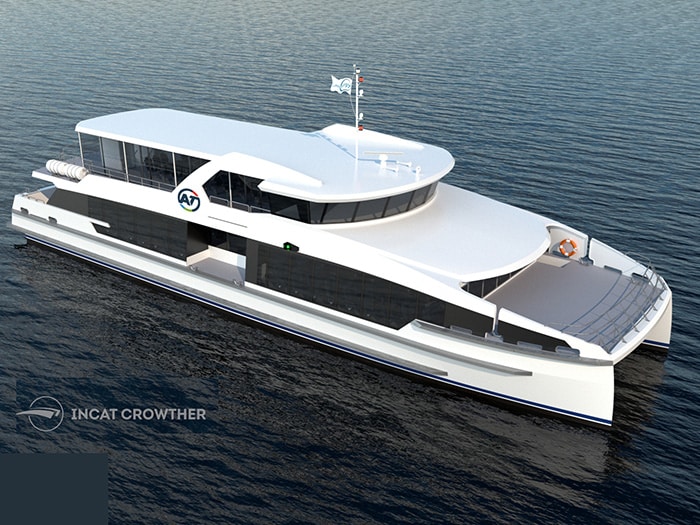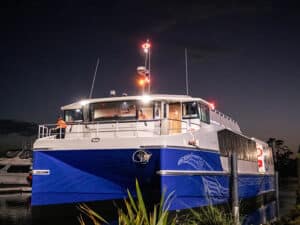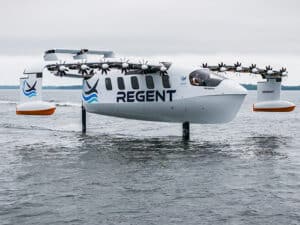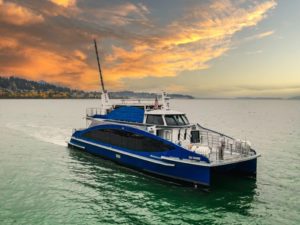
Auckland Transport orders another hybrid-electric ferry
Written by Nick Blenkey
Auckland Transport's latest low-emission ferry will be a hybrid-electric Incat Crowther 32 .
Incat Crowther has been commissioned to deliver the design for a second new 300-passenger hybrid-electric fast ferry for New Zealand’s Auckland Transport (AT). The project will see Incat Crowther work closely with Q-West Boat Builders, HamiltonJet and Fullers360 on the design, construction and delivery of the 32-meter vessel.
This is the fourth low-emission ferry confirmed for Auckland and the second being built by Q-West. AT plans to use this vessel on its Devonport route from 2026. Auckland’s first two fully electric vessels will arrive next year, built by EV Maritime at Auckland boat builders McMullen and Wing, followed by Q-West’s two electric-hybrid vessels in 2025-2026.
Auckland Transport says that more will follow in the coming years as its current diesel ferries reach the end of their working lives.
These new vessels will operate hand in hand with private owner-operated vessels as part of Auckland’s transition to low emission vessels over the coming years.
“As part of AT’s Mission Electric, we are investing in low emission public transport right across our network,” says AT’s program director for the low emission ferry program, Nathan Cammock. “Our trains are electric, all new bus purchases will be electric and now ferries will be too.”
This most recently announced vessel will start construction in late 2023 and be on the water early 2026.
It will be identical to the vessel Q-West is currently building for operation by Fullers360, at 32 meters long with space for 300 passengers and around 28 bikes.
“Our new low emission ferries have greater passenger capacity, improved accessibility, and a more consistent customer experience compared to our current fleet,” said Cammock. “With significantly more space for bikes it will make it easier for people to cycle at either end of their ferry trip.”
The new hybrid-electric ferry gives the operator a combination of efficiency and flexibility. Designed specifically for the route, the vessel will provide an efficient, low emission, quiet service between Auckland and Devonport. The vessel cabin is modular, with the main deck configured for metro operations and overflow capacity on the upper deck.
The vessel’s drivetrain consists of four Danfoss EM-PMI540-T4000 electric motors directly mounted to Hamilton HTX42 water jets, with a 1,944 kWh battery pack. to achieve maximum speeds over 28 knots. An advanced energy management system controls the deployment of the system over a range of usage profiles.
As well as the primary electric-only profile, the vessel can extend its range by a mode directly feeding the propulsion motors from its two Scania DI16 070M/Danfoss EM-PMI540-T3000 generator sets, a mode that charges the batteries from the generators, and a hybrid boost mode that combines both sources.
“This new vessel will likely be completed in Q-West’s new facility at the Whanganui Port where we will be able to maintain and repair ferries and other commercial craft. We look forward to continuing our relationship with Auckland Transport and Fullers360,” said Q-West chief executive Colin Mitchell
Fullers360 CEO Mike Horne says Fullers360 has made substantial investments in green tech research and development over the last five years, which will power these ferries.
“As a key partner in the project as well as initiating and project managing the build, we can’t wait to see these low emission vessels out on the Waitemata,” said Horne.
Incat Crowther technical manager Dan Mace said the solution developed and delivered by Fullers360, Incat Crowther, Q-West and HamiltonJet has been further validated by this announcement from Auckland Transport.
“The Incat Crowther 32 design is customer-focused and offers operational flexibility and efficiency. Digital shipbuilding technology has been utilized to accurately and reliably integrate the electric drive system into the vessel. This solution is fully tailored to the operation,” said Mace. “With another Incat Crowther-designed electric hybrid ferry, Auckland Council will continue to reduce its emissions whilst offering safe, comfortable and reliable public transport.”




